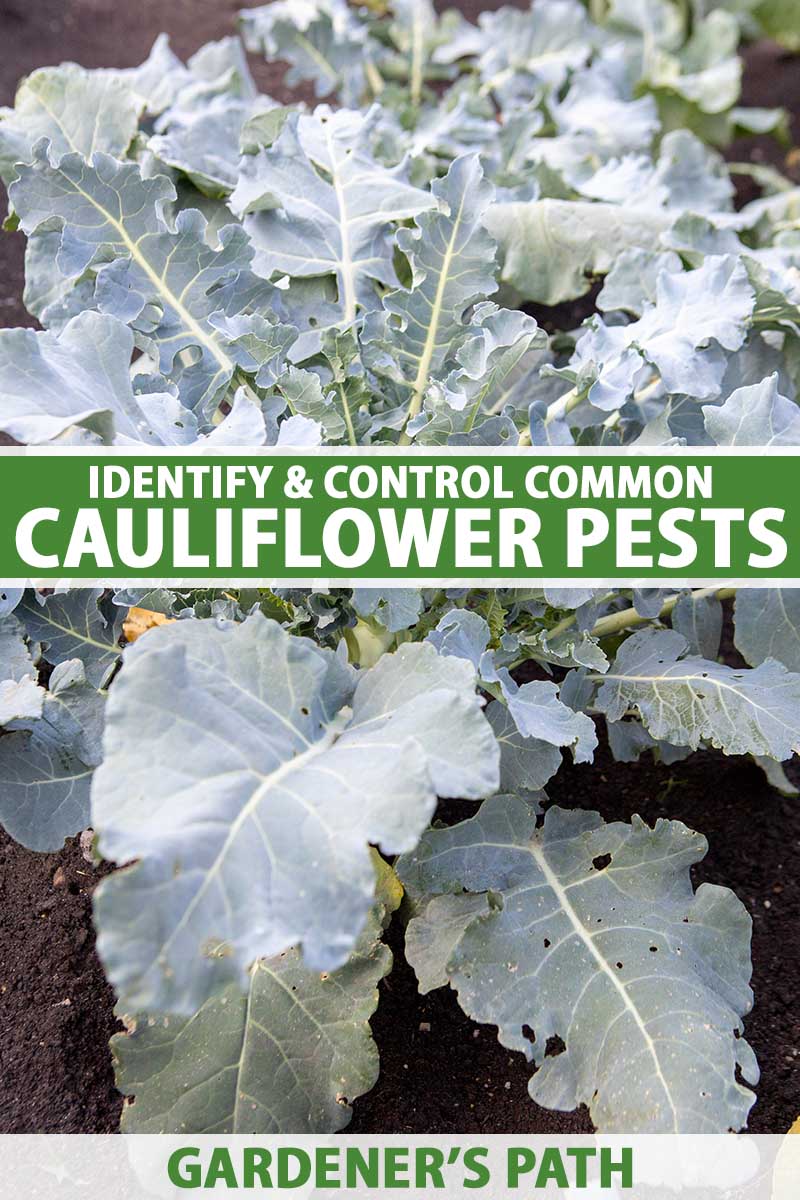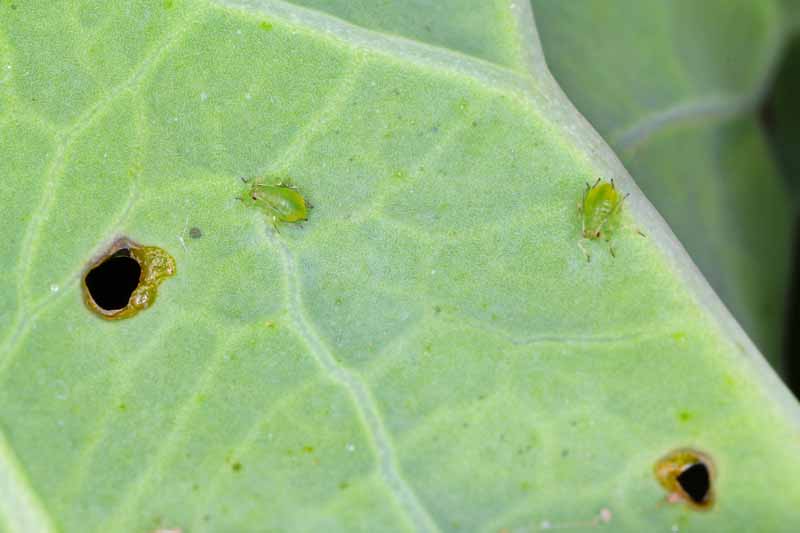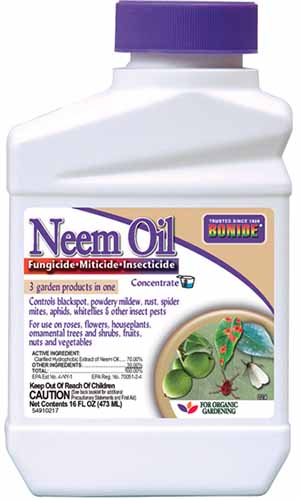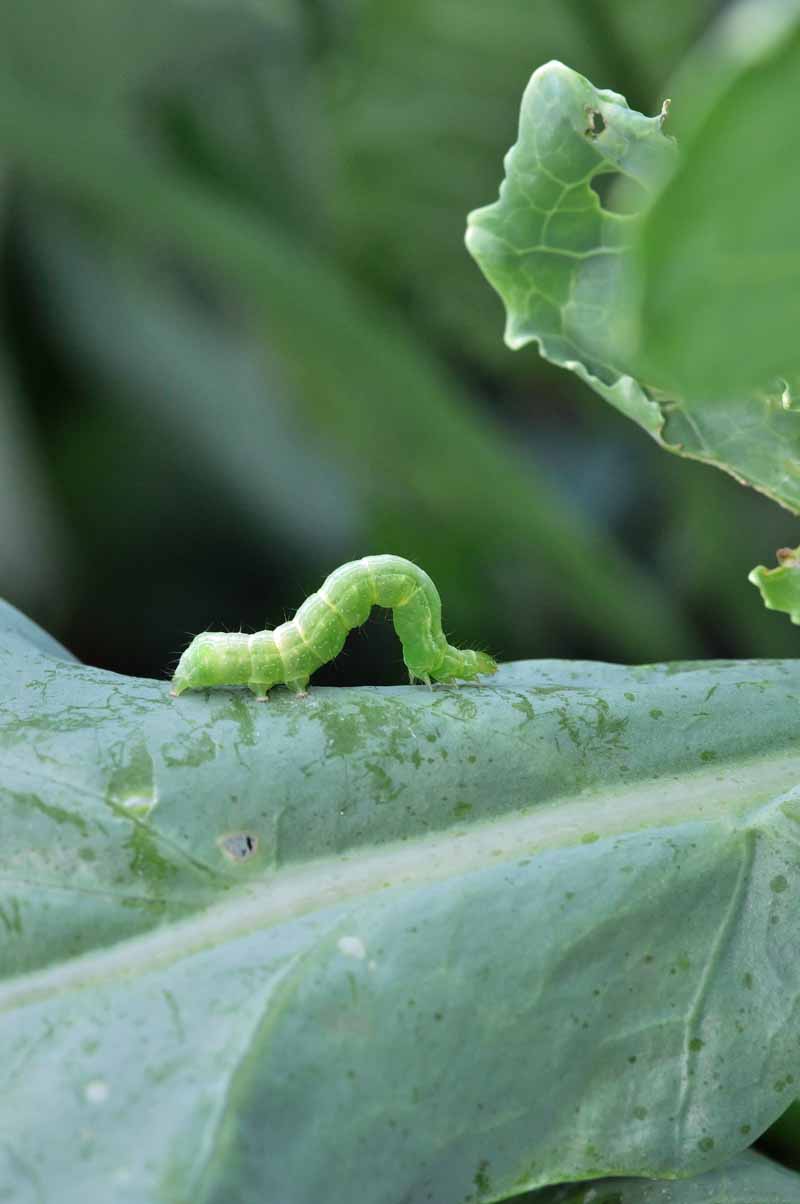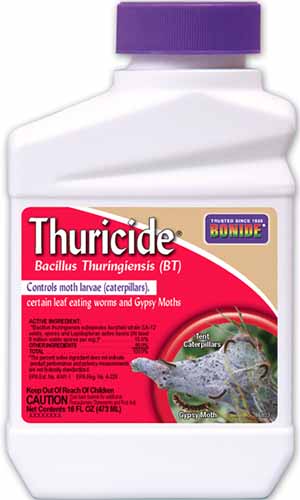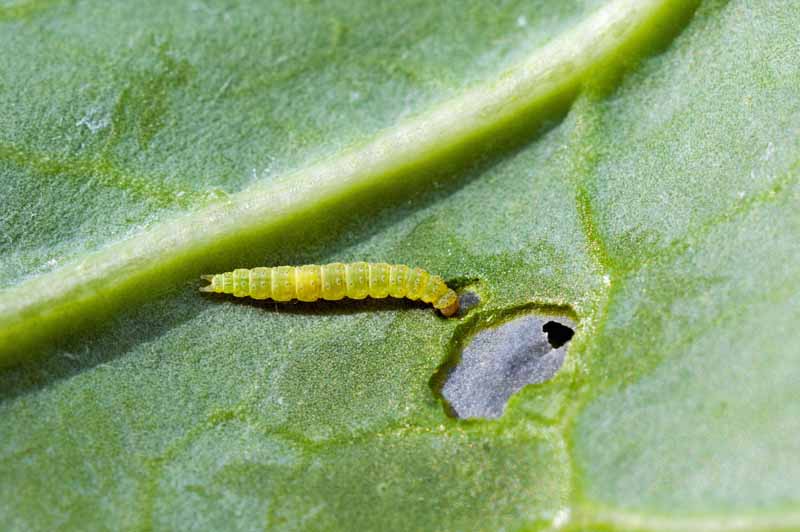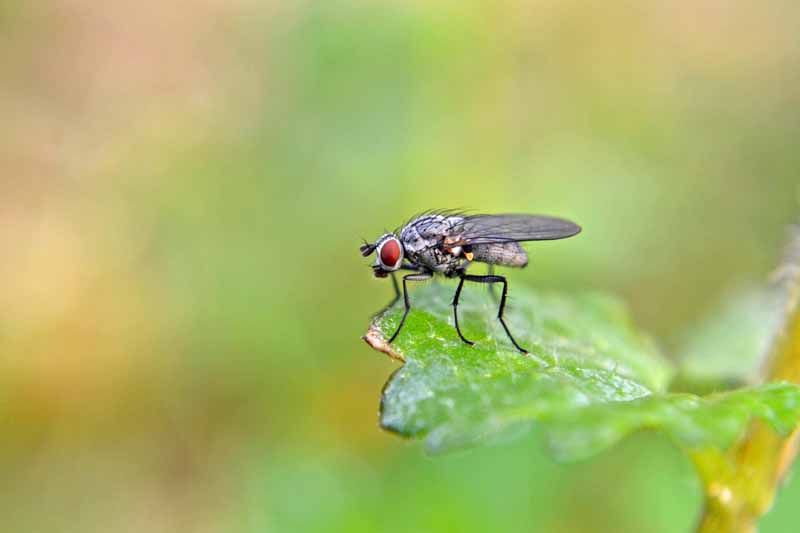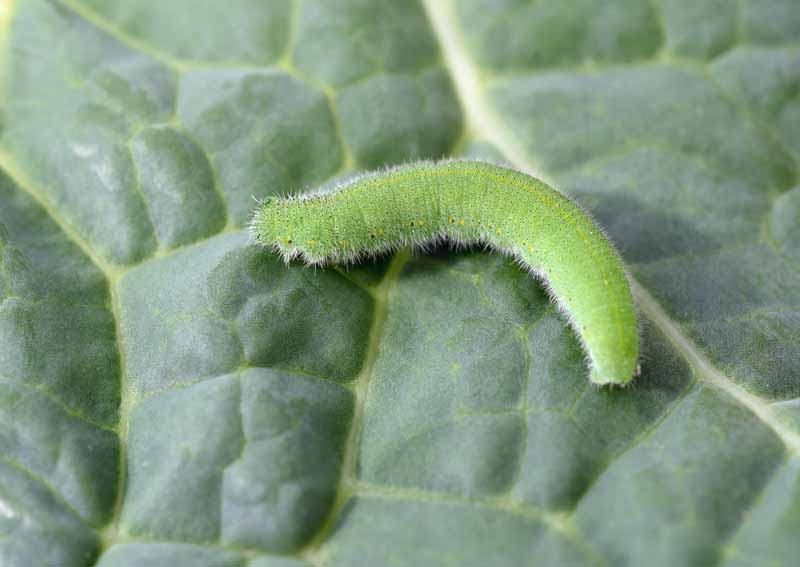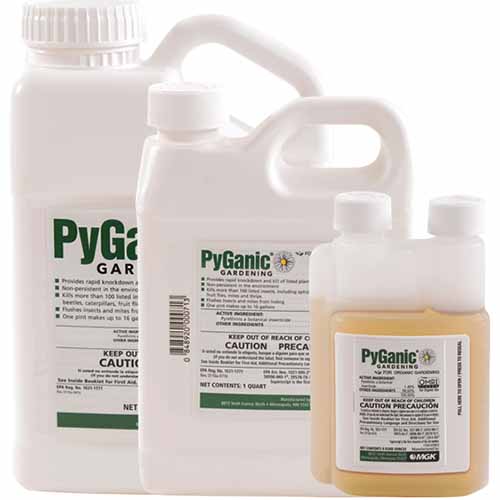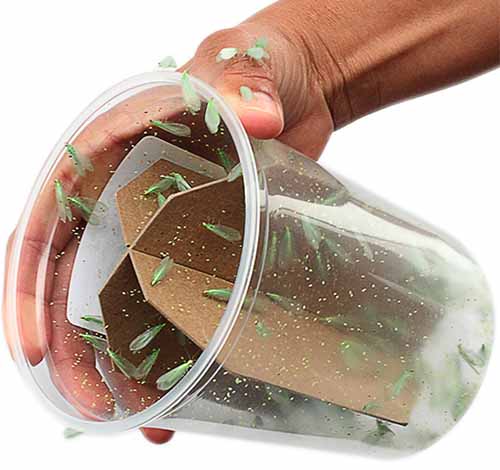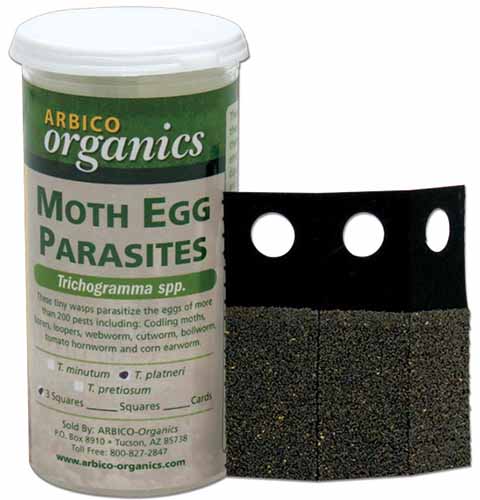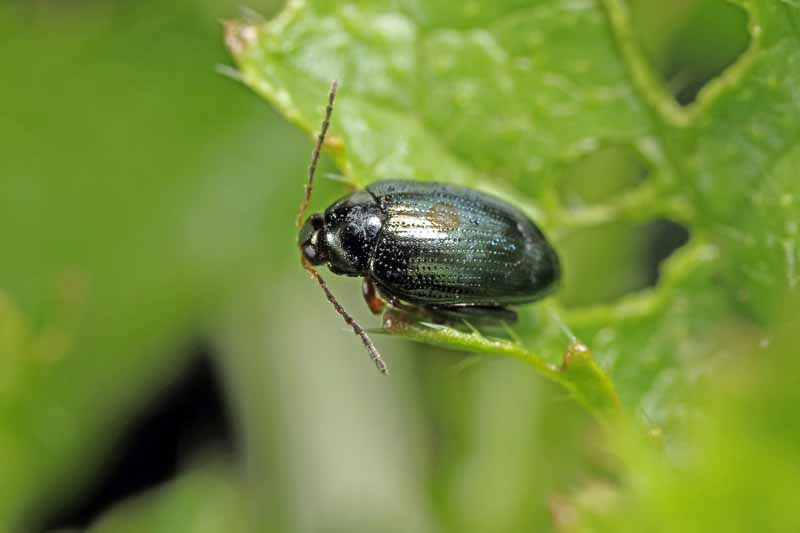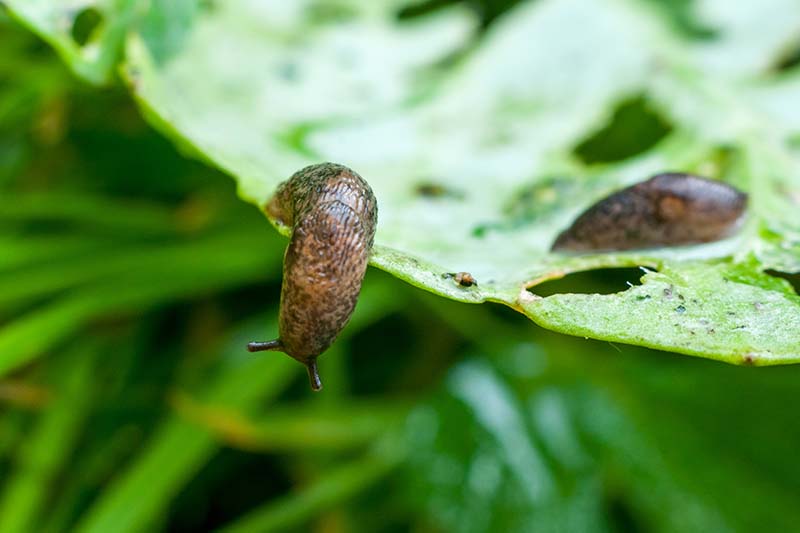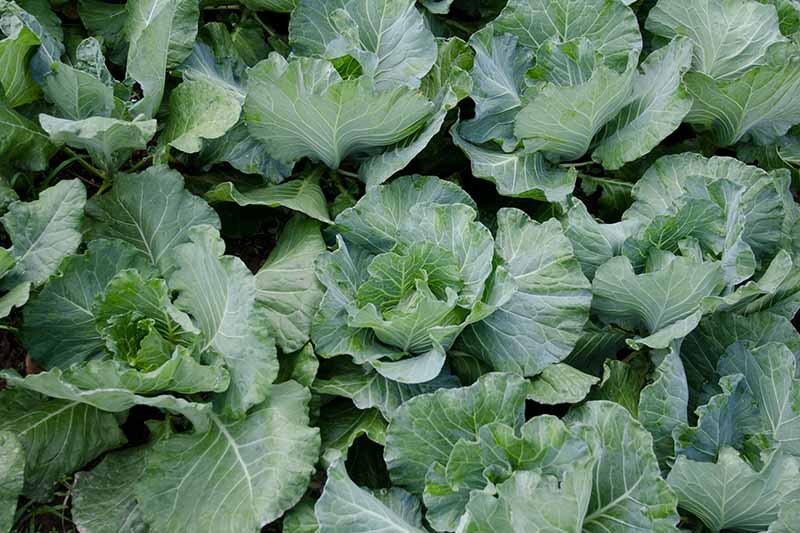And in addition to the damage pests can do to developing heads, foliage, and roots, they may also be vectors, or carriers, of plant diseases that may be detrimental to an even greater degree. We link to vendors to help you find relevant products. If you buy from one of our links, we may earn a commission. In this article, we introduce nine common cauliflower pests that you will learn to recognize and manage. Here’s the lineup: Let’s jump right in!
1. Aphids
The cabbage aphid, Brevicoryne brassicae, is a tiny sap-sucking insect that eats through leaves and heads.
2. Cabbage Loopers
Trichoplusia ni is a leaf eater that can chew a crop down to nothing in no time. Eggs are laid on the undersides of leaves, and are so tiny you may never see them. Telltale clumps of stacked up aphids, however, are visible as a yellowish patch. Start by trying to rinse them off with a steady and firm stream of water from the hose. If this proves ineffective, use a product such as neem oil, a natural insecticide and fungicide. It’s available from Arbico Organics in a variety of sizes. Bonide Neem Oil Neem oil is organic, and derived from the neem seed. In addition to being a go-to insecticide for many pests, it is an effective fungicide that is chemical-free and nontoxic to people and pets. Read more about managing aphids here. This caterpillar is unmistakable, with its distinctive inchworm-like gait, green body, and white stripe. Adults are brown moths with a distinguishing silver figure eight marking. Tiny yellowish-white eggs are laid on the undersides of leaves. Cabbage loopers do their worst damage to mature plants, tearing through leaves and right into the flower heads. A treatment with organic Bacillus thuringiensis, or Bt, is recommended.
3. Cabbage Moths
Per the experts at the Michigan State University’s Agricultural Extension, the cabbage moth, aka the diamondback moth, Plutella xylostella, is one of the most destructive insects when it comes to brassica crops. Bonide Thuricide Find Bonide Thuricide from Arbico Organics in one-quart, one-gallon, eight-ounce, and 16-ounce packages. She recommends dousing plants with white flour (not self-rising) early in the morning. Dew plus flour equals petrified bugs that may be rinsed off the following day. Find out more about cabbage looper control here. Immature larvae are transparent yellow, but they undergo color changes as they mature, and may be green/yellow striped, brown, or black. Adults are easily identified by a white diamond on their folded brown wings. Both larvae and adults are ravenous feeders that decimate entire plants. If you notice the moth, look for yellow to green eggs on the undersides of leaves. This is a difficult insect to deal with, as it has developed resistance to some pesticides. Natural predators include the parasitic wasp, a beneficial insect. You can treat with neem oil or Bt, but you may find them to be ineffective. You can also try a practice called “trap cropping,” as recommended by T. Jude Boucher, vegetable crops IPM coordinator at the University of Connecticut. It involves planting a barrier of another plant the pest likes around your brassica. In this case, collard greens are recommended. The idea is that these moths will chew the collards to bits before attacking your cauliflower. Best case scenario – you get to enjoy both crops at harvest time. Read more about planting and using trap crops here.
4. Cabbage Root Maggots
This root maggot, Delia radicum, is the larva of the cabbage root fly. This tiny brown fly lays minute, 1/8-inch eggs that contain white larvae, or maggots. When they hatch, the maggots feed on the roots of brassica crops. If you see an inordinate number of tiny flies around your crops, apply diatomaceous earth to the soil over the roots to discourage egg laying. And if your plants are showing signs of distress, dig down, examine the roots, and discard infested plants.
5. Cabbage White Butterflies
Pieris rapae lays yellow eggs on the undersides of brassica leaves. They contain larvae, or caterpillars, that are born with a voracious appetite. NemAttack Sf Beneficial Nematodes Find NemAttack Sf Beneficial Nematodes from Arbico Organics in packages containing five, 10, 50, 250, or 500 million. There’s something else you may want to try – a collar. This is a circle of felt, cardboard, or a similar material that goes around a plant at the soil level to prevent flies from laying eggs near the roots. Find it in garden centers or make your own. Also called cabbage worms or green worms these caterpillars devour leaves and bore into heads, ruining entire crops.
6. Cabbage Whiteflies
Another pest you may see is the cabbage whitefly, Aleyrodes proletella. Alternatively, you can treat your plants with Bt or pyrethrin, the organic treatments of choice for dealing with this pest. PyGanic Gardening Botanical Insecticide PyGanic Gardening’s Botanical Insecticide Pyrethrin Concentrate for Organic Gardening is available from Arbico Organics in eight-ounce, 32-ounce, and gallon-sized bottles. Read more about defeating the cabbage worm here. This tiny white fly and its young scaly nymphs infest the undersides of leaves, feeding on leaf sap, and excreting “honeydew” that promotes sooty mold growth. But while this type of whitefly disfigures a plant’s leaves, it doesn’t damage the heads, so many growers simply put up with it. Experts at the Royal Horticultural Society are of the opinion that unless an infestation is severe, it probably doesn’t need to be addressed with pesticides. However, if you go that route, know that treating the undersides of leaves is a temporary fix, and product instructions must be followed diligently with reference to selecting the right one for the right crop, as well as safe harvest intervals for application.
7. Cross-Striped Cabbage Worms
Per the pros at the University of Massachusetts, Amherst Center for Agriculture, Food, and the Environment, the cross-striped cabbage worm, Evergestis rimosalis, is easily distinguished from other brassica pests in the egg stage. Adult Lacewings Find lacewings now from Arbico Organics in packages containing 100, 250, or 500 pre-fed adults. Adult lacewings feed on whiteflies as well as caterpillars, making them a valuable addition to the garden. They live for four to six weeks. Read more about managing whiteflies here. This is because it is the only species to lay eggs in clusters that look like flat yellow patches on the undersides of foliage. The larva, or caterpillar, is blue-gray with black stripes on top, and solid green underneath. It feeds on leaves and works its way into the heads before maturing into the brown moth with translucent lower wings that you may notice fluttering around your plants. You can handpick the caterpillars when you see them, or you can be proactive with a biological control. An effective course of action is the use of moth egg parasites, Trichogramma brassicae. These are parasitic wasps that feed on the eggs before they hatch. You can also treat an outbreak with an application of Bt or pyrethrin, the organic pesticides described earlier. Tiny and non-stinging, these beneficial insects live for about two weeks. Moth Egg Parasites Purchased wasps are shipped in the egg phase, attached to cards. You hang these up near the cauliflower plants, out of direct sunlight, where the moths are active. When they hatch, the wasps seek their prey. Moth Egg Parasites are available from Arbico Organics in packages containing three tabs, six tabs, and a 30-tab card. Take care not to touch the fragile eggs when placing the cards. And you can also attract parasitic wasps to the garden with umbel flowers that have flattened heads covered in tiny blossoms. Read about suitable cauliflower companion plants here.
8. Flea Beetles
The crucifer flea beetle, Phyllotreta cruciferae, and the striped flea beetle, Phyllotreta striolata, chew the leaves of brassicas, but generally make shallow cuts that don’t pierce all the way through the leaves. You can recognize them most notably by their extra-large hind legs that enable them to jump like fleas. A pyrethroid foliar spray is the recommended chemical treatment. This is a synthetic compound not to be confused with natural pyrethrin, which has a botanical derivation. There is no organic product available for treating flea beetles. However, the use of floating row covers, or planting around the life cycle of the beetles, may be helpful. You may also try trap cropping as a first line of defense with a flea beetle favorite, mustard. Read more about defeating flea beetles here. From their homes deep in the soil, where they live and lay their eggs, these night-feeding pests emerge. They are most active when the weather is cloudy, cool, and damp, preferring shady places and overwatered conditions. Suggested remedies vary. Many involve luring the gastropods into containers from which they cannot escape, such as the Snailer Snail and Slug Trap. Snailer Snail and Slug Trap Find the Snailer Snail and Slug Trap from Arbico Organics. Choose from a single trap with a one-month bait supply; two traps with four, two-month baits; a two-month bait refill, and a packet of five two-month bait refills. They are safe for use near people and pets. Other treatments include products containing iron phosphate. They are nontoxic to people and pets, and cause slugs and snails to lose their ability to feed. Bonide Slug Magic This product is in granular form and is sprinkled on the soil around the affected plants. Find Bonide Slug Magic from Arbico Organics in one-pound containers. Remember not to overwater. As stated in our growing guide, one to two inches of water per week in the absence of rain is generally sufficient. Learn more about slug and snail control here.
Where There’s a Will…
With an understanding of these common cauliflower pests, you can stay one step ahead of them in the garden, and will be well on your way to producing a successful crop. Watch for signs of their presence, like eggs beneath the leaves; caterpillars; hovering flies, brownish moths, and small white butterflies; as well as chewed foliage and heads. And remember, pests may also serve as a source of disease. Check out our guide to common cauliflower diseases to learn more. Yikes! If the notion of having to watch for and manage pests is really turning you off when it comes to vegetable gardening, wait! Before you put down that shovel, there’s another way. By placing those floating row covers we mentioned over crops from the start, you can greatly reduce the potential for insect damage. They also come in handy when the temperature takes a sudden nosedive, or spikes to above normal highs. In addition, you may want to do raised bed or container gardening to minimize the risk of infestation by soil-dwelling insects. Where there’s a will, there’s a way, and when you harvest that first crop, your efforts will be deliciously rewarded. Have you dealt with cauliflower pests? Please share your experience with us in the comments section below. If you found this article informative, we recommend reading the following cauliflower guides next:
13 of the Best Cauliflower Varieties for the Home Veggie GardenWhen and How to Blanch Maturing Cauliflower HeadsWhen and How to Harvest CauliflowerHow to Grow and Care for Romanesco Broccoli
